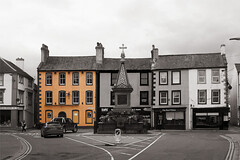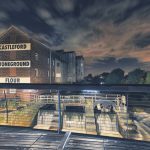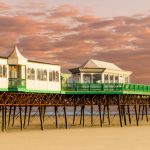
A quick guide to Wigton
Wigton is a small market town in Cumbria, north-west England. It’s situated about 12 miles south-west of Carlisle and 16 miles north-east of Maryport, between the Caldbeck Fells and the Solway coast, on the fringe of the Lake District. It’s an ancient settlement dating back to pre-medieval times. In the 2011 census, the population of Wigton was recorded as being 5,831.
Go to the Cumbria Business Directory
Wigton, A Fleeting History
The Romans were the first known settlers in the area, establishing a fort (Maglona) and large civilian settlement, just south of the present town. The fort complex became known by locals as ‘Old Carlisle’. It’s thought that the Roman cavalry based at the fort were utilised as a rapid response force to ward off incursions at Hadrian’s Wall. In the period immediately after Roman rule, Wigton formed part of the native kingdom of Rheged. At some time during the dark ages, Wigton became an established settlement forming part of Anglian Kingdom of Northumbria. By the time William I had the Domesday Book prepared in 1086, Wigton along with most of ancient Cumberland, formed part of Scotland. Thus, the town was never documented as part of the Doomsday manuscript.
In 1092, Carlisle Castle was built by the Normans to serve as a regional seat of power and administrative centre. Odard de Logis was appointed as Sheriff of Carlisle, and subsequently made Baron of Wigton, around 1100. In early 13th century, the ‘de Logis’ barony changed their surname to ‘de Wigton’. However, in 1348, the male line of the ‘de Wigton’ family died out, so the jurisdiction for Wigton passed to the Barony of Cockermouth.
In 1262, Wigton received a market charter from Henry III. The triangular market place that evolved in the town centre, very much became the focal point of life in medieval Wigton. The town’s market survives to this day, taking place every Tuesday.
By the late 17th century, Wigton had begun to develop a linen trade, initially as a cottage industry and natural extension of its agricultural function. The linen industry continued to grow through the 18th century and eventually the trade was taken over by industrial manufacturers. It was during the Georgian period that much of ‘old’ Wigton was constructed. In 1788, St. Mary’s Church was built at Church Street, where a church had stood since the 12th century.
In 1845, the Maryport & Carlisle Railway line was launched, which saw a train station being constructed just outside the town. The land between the old town and new railway line became increasing tied over to industrial development. By the mid-19th century, a shirt factory, print works, a factory producing cotton, linen and woollens, and three dyeworks, had all set up in the town. Other industries included two tanneries, four breweries and three nail factories.
In 1857, Charles Dickens and his literary peer Wilkie Collins, passed through Wigton staying at the King’s Arms Hotel, on their epic incognito tour of northern England. Their derisive account of Victorian Wigton can be found in the co-authored short story ‘The Lazy Tour of the Two Idle Apprentices’.
In 1868, the shirt factory was taken over by Samuel Redmayne, who established Wigton’s Clothing Factory. By 1900, the linen industry had significantly declined, and tanning became the town’s principal industry. In 1901, Burnfoot Preserves Works (jam factory) established themselves in the town. However, by 1934 the jam factory had closed. In 1936, British New Wrap Co. opened a factory at the site, producing a variety of cellophane wrapping and labelling products.
Wigton’s population almost doubled between 1801 and 1831, i.e. from 2,450 to 4,885. However, at the end of the century it had declined to around 4,000, dropping further to a low of 3,521 by 1931. It then gradually increased during the rest of the 20th century to stand at 5,360 in 2001.
The Modern Era
Redmayne’s clothing factory remained a leading employer in the town until late 20th century, the building been eventually demolished in 1987. The town’s main employment today is concerned with the manufacture of cellophane. The cellophane factory slowly expanded under the ownership of British Rayophane, then British Sidac, and then as a wholly owned subsidiary of the UCB Group. A new factory was built in 1963, and further major expansion took place in 1990’s, when it employed around 1500 at it’s peak. Today, the factory is the global head office of Innovia Films Ltd., employing around 600 people.
Today Wigton is a thriving market town, with livestock auctions being held regularly at Hopes Auction Company. Many of Wigton’s 18th century Georgian buildings have survived largely intact. And so have its jumble of streets, narrow lanes and alleyways, which earned it the nickname of the *throstle’s nest. The naming of which has been accredited to a returning soldier from WWI.
- An old-fashioned term for a song thrush
Getting there!
If you’re travelling by car, then getting to Wigton, is relatively easy. Arriving at Carlisle, via the M6, you need to take the A595 south-west out of the city for about 5 miles. At Thursby roundabout, turn on to the A596. It’s a further 6 miles to Wigton.
You get to Wigton by rail, by first taking the train to Carlisle. You then need to change for the train running to Whitehaven/Barrow on the Cumbria Coast Line. Trains run approximately every hour, with the journey taking around 20 minutes.
Stagecoach operate 6 buses between Carlisle and Wigton, Monday to Saturday, with a reduced service on Sunday. Buses run around every 2 hours, from early morning to late afternoon. The journey takes around 30 minutes, making frequent stops along the way.
Places to see in Wigton!
Memorial Fountain
The town’s ornamental Memorial Fountain in the centre of town at Market Place is worth a look. The fountain was commissioned by George Moore in 1872, a local businessman and philanthropist, in memory of his first wife Elisa. The fountain, made of Shap ‘pink’ granite, has four plagues depicting the “four acts of mercy” by renowned pre-Raphaelite sculptor Thomas Woolner.
St Mary’s Church
St Mary’s is a beautiful Georgian Church built in 1788 on a site where a church has stood since the 12th century. It has a classical Harrison & Harrison organ and fine stained glass windows, as well as alluring interior galleries. It is open every day and welcomes visitors.
Things to do in Wigton!
Walk around Wigton
Wigton Civic Trust have published a booklet: ‘A Walk around Wigton – three urban trails’. The talking book was researched by the pupils from the local Nelson Thomlinson School. Narrated by Wigton’s most famous son, renowned writer and broadcaster Melvyn Bragg (aka Lord Bragg of Wigton) ‘Speak For England’ is an oral history of the present century, based on interviews with the town’s people.
Watchtree Nature Reserve
Watchtree is about 5 miles north-east of Wigton at Wiggonby, along the A596. The reserve has miles of tracks and trails, wide open spaces and woodlands as well as great views towards the Lakeland fells. As well as a elemental garden, there are also orienteering courses and cycle routes for the more active. There’s a great variety of habitat at the reserve, so you can expect to see plenty wildlife, including hares, roe deer, curlew, skylarks and great crested newts. There’s also the customary visitor’s centre and coffee shop.
Places to Stay?
Being a small town, accommodation in and close to Wigton itself, is obviously fairly limited. However, there are a few decent hotels and guesthouses not too far afield. If you prefer holiday home style accommodation, there are a good number in the general area. A rough guide to accommodation for the Wigton area are as follows:
Hotels/Guesthouses/B & B: £70 – £90
Holiday Homes: £60 – £80 (pp per night for max occupancy)
Banner Credit : murtica27:Flickr
Think you know Wigton? Why not take the our fun quiz on Wigton?
Quiz Maker – powered by Riddle




